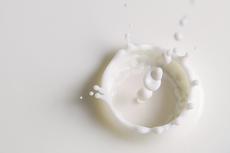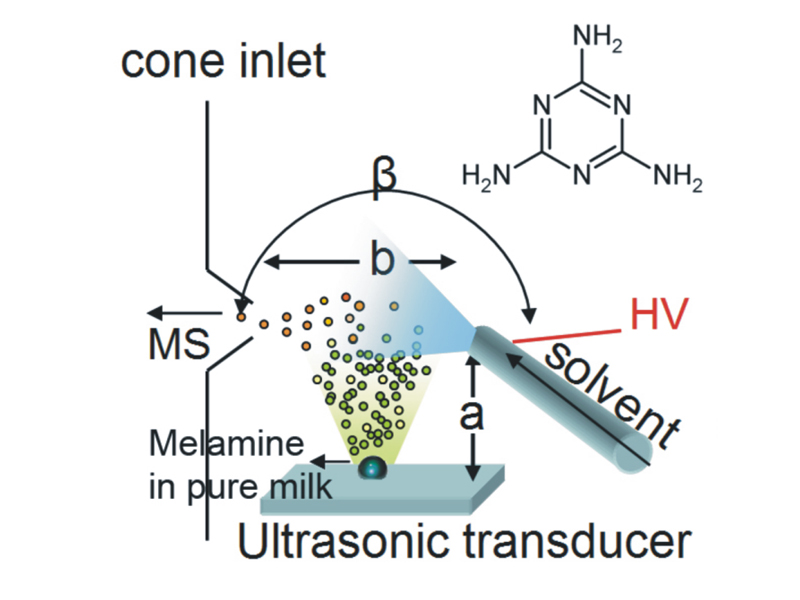Instant detection of melamine in milk
So far, six babies have died and a further 300,000 have been taken ill in China due to milk contaminated with melamine. ETH Zurich chemists Renato Zenobi, Huanwen Chen, and colleagues have developed a new mass spectrometric analysis method with which polluted milk can be detected reliably within 30 seconds.

Melamine is a white powder normally used to produce synthetic resins or as an additive in fertilizer. A single molecule with a relatively small molecular mass contains six nitrogen atoms. This property is exactly what the Chinese milk adulterators exploited to make milk diluted with water appear to be of high quality. The protein content of milk is used as a measure of its quality and is normally determined via the milk’s nitrogen content. If melamine is added to milk, its nitrogen content increases and so does the supposed quality of the milk measured on that basis. If the chemical at high concentration binds to cyanuric acid, which is used as a disinfectant, it forms insoluble crystals that can produce fatal kidney stones. This reaction has caused the death of six babies in China since September 2008. The level of melamine found in Chinese milk was more than 1,000 times higher than the maximum value of 2.5 ppm (parts per million) permissible in foods according to European legislation.
Analysis result in half a minute
The scandal in China and the sudden demand for fast, reliable analysis methods to detect melamine brought analysts on to the scene throughout the world, among them Renato Zenobi’s group at the Organic Chemistry Laboratory of ETH Zurich. Zenobi is well known as an innovator in the field of mass spectrometry (MS), and recently presented a new method to determine pesticide residues in foods (see www.ethlife.ethz.ch). MS is a standard method in analytical chemistry in which charged molecules in a sample mixture are identified on the basis of their molecular weight. In the current issue of the scientific journal “Chemical Communications”, Zenobi and colleagues describe a new MS-based method to determine the concentration of melamine in milk quickly and reliably.
They do this by using a method known as Extractive Electrospray Ionisation (EESI), which the chemists first presented in January 2007. EESI involves feeding the sample mixture in the form of an aerosol or fine dispersion into a conventional electrospray (see diagram). In this process, the sample is extracted into the charged droplets created in the electrospray source and is simultaneously ionised. The resulting ions are then analysed by the mass spectrometer. In the case of milk, ultrasound must also be used first of all to atomise the sample so it can be entrained into the electrospray for MS analysis.
Explaining the advantages, Zenobi says, “Using ultrasound-assisted EESI-MS, we can analyse milk directly without any sample preparation steps. The method is fast and very accurate, and needs no more than one drop of milk.” Previously, an analysis required between twenty and sixty minutes to determine the concentration of melamine in a milk sample using standard methods. Zenobi’s group can do it in just 30 seconds. The current publication describes the analysis of milk, milk powder and wheat gluten, but, according to Zenobi, EESI-MS can, in principle, be used to determine the level of melamine in any foodstuff. The detection limit is 500 ppb (parts per billion) – which is five times less than the limit value allowed in foods in the USA and EU.
Portable EESI-MS for on-site analyses
A comparable analysis method for melamine was published in the same issue of “Chemical Communications” by one of Zenobi’s colleagues - R. Graham Cooks from Purdue University, USA. However, Cooks atomises and ionises his milk sample by bombarding it with a charged gas (low-temperature plasma; LTP). Zenobi is happy to say that, “Both methods are accurate, fast and robust. Our results are practically identical; the fact that they now appear in the same journal is an amusing coincidence. I really knew nothing of Graham’s melamine project until a short time ago.” At present, the chemist is unwilling to speculate as to whether one of the methods will ultimately become established, and if so, which one. In principle, both methods can be used by any laboratory equipped with an electrospray MS without significant additional expense. Nevertheless, Zenobi is not overly confident that the methods will gain immediate acceptance in foodstuffs testing laboratories: “Established methods usually persist for a very long time – it is hard for innovations to gain a foothold.”
His group is currently working to develop the method further for use in the field. The scientists have in mind a portable instrument that could be used to measure the melamine content directly when the milk is being processed, for example during bottling. Explaining the essential advantage of such an analysis instrument, Zenobi says, “The shorter analysis time is one thing, but the majority of the time - and therefore money - is lost during all the logistics connected with taking the sample.” He is still to receive a direct enquiry from China regarding application of the technology. However, easy-to-handle analysis instruments based on EESI-MS technology might one day contribute to preventing a food scandal such as the one in China at an early stage.
References
Zhu L, Gamez G, Chen H, Chingin K, Zenobi R. Rapid detection of melamine in untreated milk
and wheat gluten by ultrasound-assisted extractive electrospray
ionization mass spectrometry (EESI-MS). Chem. Commun. 2009; Advanced online publication doi:10.1039/b818541g
Huang G, Ouyang Z, Cooks RG.High-throughput trace melamine analysis in complex mixtures. Chem. Commun. doi:10.1039/b818059h








READER COMMENTS